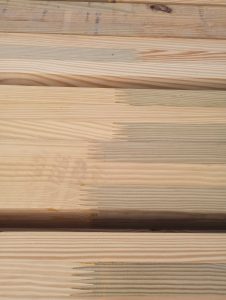While splicing two pieces of wood together end-to-end might on the surface seem to be not such a big deal, the reality is that it has always been challenging and at times difficult.
If you missed yesterday’s blog – I encourage you to go back and read it. Will take you but a few minutes. To continue with my saga on finger joints….
 Structurally, finger joints are often seen in glue laminated beams and columns and the top and bottom members of I joists. The actual forming (or cutting) of the fingers is critically important.
Structurally, finger joints are often seen in glue laminated beams and columns and the top and bottom members of I joists. The actual forming (or cutting) of the fingers is critically important.
The most common method of forming the finger joint profile is with cutting tools. The cutting tool is normally a revolving head made up of a series of stacked knives, shaped saw blades or a head which holds replaceable bits. The size and number of cutters in a head depends upon the geometry of a joint and the thickness of width of material being joined.
If stacked knives are used to form structural end joints, the tolerances in the knives and their assembly in the head is extremely crucial. A few thousands of an inch variation can result in poor fitting, low-strength finger joints.
Several approaches are available to apply adhesive to a surface of a joint. Sophisticated finger jointed operations make use of some type of mechanical applicator. A common type is a revolving metal drum with a surface having the same profile as the finger joint. The surface of the drum is continuously coated with fresh adhesive. As the joint passes the revolving drum, the adhesive is wiped onto the joint surface. A variation of this is to use a shaped brush which revolves and wipes the adhesive onto finger joint surfaces.
A second type of applicator is a stationary extruder nozzle, also shaped with a matching profile of a joint. As the joint passes the nozzle, a quantity of adhesive is extruded onto the finger joint surfaces.
None of the systems is completely satisfactory. The control of the amount of adhesive applied is not always precise, and the nozzles and spreaders may become clogged with debris, requiring frequent checking and maintenance.
After an adhesive has been applied, the next step is aligning the finger joint and applying pressure.
Several systems are available by which pressure can be applied. In one system, the required pressure is applied by having the infeed mechanism in the bonding or curing area move at a faster rate than the outfeed end of the line. This is commonly called a crowder. The crowder system is often used if material being joined continues to move as it passes through an RF curing tunnel.
In another system a stationary clamp and a movable clamp are used. The stationary clamp grabs onto a piece on one side of the joint and holds it in place while the movable clamp grips the piece on the opposite side of the finger joint and moves forward, forcing the two halves together. This system, sometimes called a stop- and go-system, also is used with RF curing, but here the joint is stopped and held in position between the electrodes of the RF generator.
In the Mini-Joint system, the pressure applied is high and, after being held for two or three seconds, it is released. The frictional forces developed between the two halves suffices to hold them together and allow normal handling while the adhesive cures at ambient conditions.
Regardless of how pressure is applied it is important it be of sufficient magnitude to force the two halves tightly together and the pieces be properly aligned while the adhesive cures.
Phenol-resorcinol adhesives are not affected by the commonly used preservative treatments. They will also bond treated wood, making it possible to treat the wood and then glue the assemblies. Phenol-resorcinols are modifications of straight resorcinol resin adhesives produced by polymerizing the two resins (phenol-formaldehyde and resorcinol-formaldehyde). The principal advantage of the copolymer resins over straight resorcinol resins is their significantly lower cost; the price of phenol is much lower than resorcinol. This cost advantage apparently is achieved without any significant loss in joint performance. For wood gluing, the volume of phenol-resorcinol used far exceeds straight resorcinol. Proportions of the two resin components in the copolymer generally are not revealed by manufacturers. Like their components, the copolymer resins are dark-reddish liquids, and are prepared for use by adding powdered hardeners. The hardeners generally consist of paraformaldehyde and walnut shell flour, mixed in equal parts by weight.
I had always been told the toughest part of manufacturing glue laminated columns for post frame buildings was getting the finger joints right. But it wasn’t until after I began researching this post I came to realize how complex the whole process is. For those who can and do get it right every day, I am impressed!






